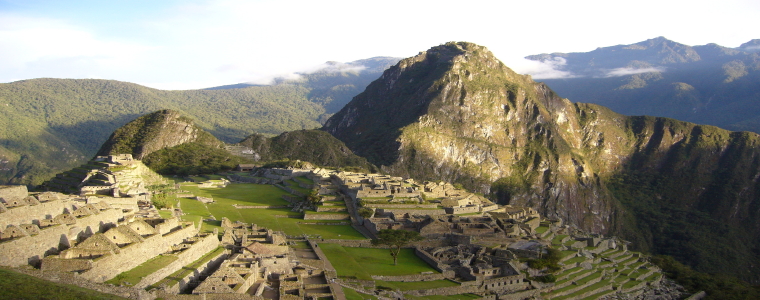|
The following is a list of the places we visited in Peru with a
brief description of each. If you click on a location, you will
go to a page with more detailed descriptions of our activities there
and photos of some of the sites. For additional photos of any area,
please go to the Photo Gallery.
Sacred Valley-Urubamba
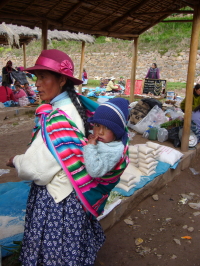 Urubamba
is the largest town in the Sacred Valley with around 20,000 people.
The Sacred Valley lies along the Urubamba River and was very important
to the Incas. Here they built their retreats, palaces and sacred
places. It is called sacred due to the glacier topped mountains,
the fertile soil and the corn which was grown for the nobility during
Inca times. Our first stop was the market in Chinchera. Every Sunday,
the locals come to Chinchera to buy their produce, sell their crafts
and socialize with their neighbors. It was our first look at the
colorful dresses and unique hats worn by the Peruvian women. And
the beautiful, wide-eyed children. Urubamba
is the largest town in the Sacred Valley with around 20,000 people.
The Sacred Valley lies along the Urubamba River and was very important
to the Incas. Here they built their retreats, palaces and sacred
places. It is called sacred due to the glacier topped mountains,
the fertile soil and the corn which was grown for the nobility during
Inca times. Our first stop was the market in Chinchera. Every Sunday,
the locals come to Chinchera to buy their produce, sell their crafts
and socialize with their neighbors. It was our first look at the
colorful dresses and unique hats worn by the Peruvian women. And
the beautiful, wide-eyed children.
Pisac Ruins
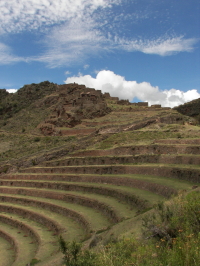 The
Spanish town of Pisac was built on an Inca settlement in the shadow
of the great stone terraces of the Inca ruins. The ruins are on
a ridge overlooking the fertile Urubamba Valley. The Incas built
the terraces to the top of the mountain for cultivation and erosion
control. Many tombs have been found here and there is a rare Intihuatana
- a sacred carving or "hitching post of the sun". The
Spanish town of Pisac was built on an Inca settlement in the shadow
of the great stone terraces of the Inca ruins. The ruins are on
a ridge overlooking the fertile Urubamba Valley. The Incas built
the terraces to the top of the mountain for cultivation and erosion
control. Many tombs have been found here and there is a rare Intihuatana
- a sacred carving or "hitching post of the sun".
Ollantaytambo Ruins
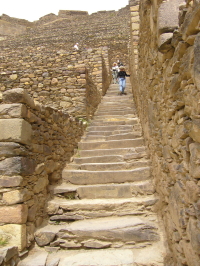 At
the end of the paved road that runs from Cusco to the Sacred Valley
of the Incas is the imposing fortress of Ollantaytambo. It gives
a good approximation of what the Inca town must have looked like
five centuries ago. We climbed over 300 steps to the top of the
fortress to the temple area. We could see graineries built into
the mountain where the Incas stored their grain, fruits and potatoes. At
the end of the paved road that runs from Cusco to the Sacred Valley
of the Incas is the imposing fortress of Ollantaytambo. It gives
a good approximation of what the Inca town must have looked like
five centuries ago. We climbed over 300 steps to the top of the
fortress to the temple area. We could see graineries built into
the mountain where the Incas stored their grain, fruits and potatoes.
Machu Picchu
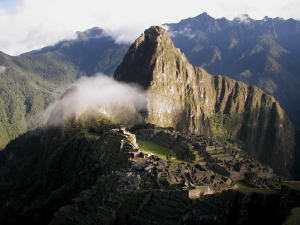 Machu
Picchu was discovered almost by accident by an American explorer
and professor of History, Hiram Bingham, in 1911. Besides the high
quality of its architectural development and Inca masonry art, Machu
Picchu owes a great part of its beauty to the surrounding landscape
and majestic location of the city. It is surrounded by the glacier
covered Andes Mountains. The Inca city of Machu Picchu is comprised
of temples, palaces, shrines, plazas, streets, baths and some 200
dwellings which must have housed an exclusive cast of noblemen and
the privileged. It also contains a wide zone of terraces with irrigation
channels that were used for planting potatoes and maise to feed
an estimated 1,000 residents. Machu
Picchu was discovered almost by accident by an American explorer
and professor of History, Hiram Bingham, in 1911. Besides the high
quality of its architectural development and Inca masonry art, Machu
Picchu owes a great part of its beauty to the surrounding landscape
and majestic location of the city. It is surrounded by the glacier
covered Andes Mountains. The Inca city of Machu Picchu is comprised
of temples, palaces, shrines, plazas, streets, baths and some 200
dwellings which must have housed an exclusive cast of noblemen and
the privileged. It also contains a wide zone of terraces with irrigation
channels that were used for planting potatoes and maise to feed
an estimated 1,000 residents.
Cusco
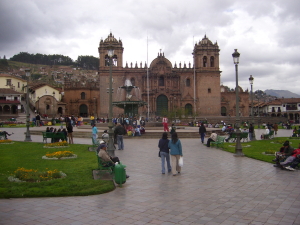 Cusco
is the oldest continuously inhabited city in the Western Hemisphere
and was the capital of the Incas. It has a population of over 400,000
people, many of whom live in the highlands surrounding the city
center. The city of Cusco is a fascinating mix of Inca and colonial
Spanish architecture. Almost every central street has remains of
Inca walls, arches and doorways. And the perfect Inca stonework
now serves as the foundations for more modern dwellings. The heart
of the city, as in Inca days, is the Plaza de Armas. Around it are
colonial arcades and four churches. While in Cusco, we visited the
main cathedral built in the 17th centruy, the old Inca Fortress
of Sacsayhuaman and the Santo Domingo Monastery, built on top of
the walls of the Inca Koricancha Temple of the Sun and from its
stones. Cusco
is the oldest continuously inhabited city in the Western Hemisphere
and was the capital of the Incas. It has a population of over 400,000
people, many of whom live in the highlands surrounding the city
center. The city of Cusco is a fascinating mix of Inca and colonial
Spanish architecture. Almost every central street has remains of
Inca walls, arches and doorways. And the perfect Inca stonework
now serves as the foundations for more modern dwellings. The heart
of the city, as in Inca days, is the Plaza de Armas. Around it are
colonial arcades and four churches. While in Cusco, we visited the
main cathedral built in the 17th centruy, the old Inca Fortress
of Sacsayhuaman and the Santo Domingo Monastery, built on top of
the walls of the Inca Koricancha Temple of the Sun and from its
stones.
Lima
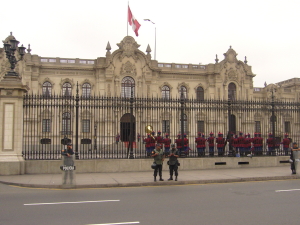 From
Cusco we flew back to Lima. This time we arrived in time for a bus
tour of the city. Lima, named the "City of Kings" by the
Spanish conquerors, is the country's capital as well as the main
gateway into Peru. The city was founded in 1535 by Spanish conqueror
Francisco Pizarro and remained the seat of Spain's New World empire
for 300 years. Today, Lima is a sprawling coastal metropolis of
8 million people. From
Cusco we flew back to Lima. This time we arrived in time for a bus
tour of the city. Lima, named the "City of Kings" by the
Spanish conquerors, is the country's capital as well as the main
gateway into Peru. The city was founded in 1535 by Spanish conqueror
Francisco Pizarro and remained the seat of Spain's New World empire
for 300 years. Today, Lima is a sprawling coastal metropolis of
8 million people.
Home Location
Descriptions Photos Map
Contact Us
|
